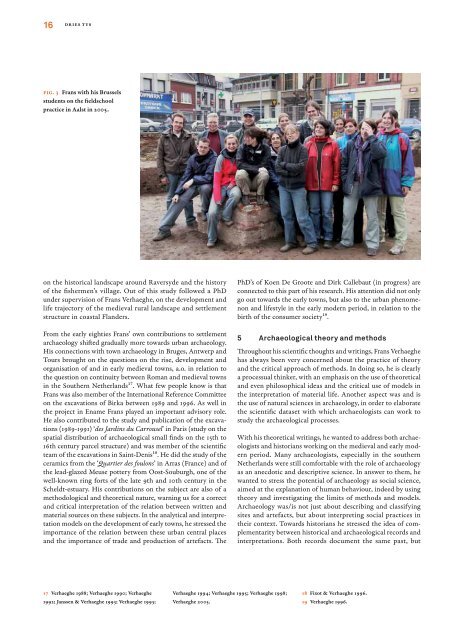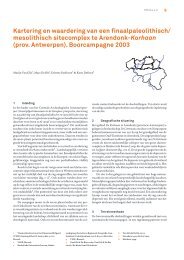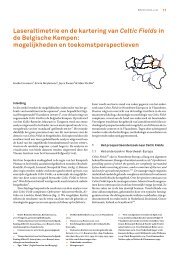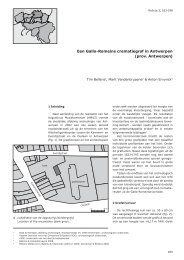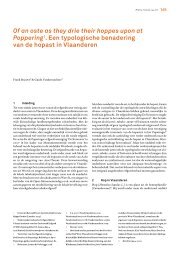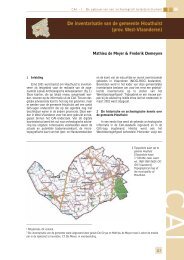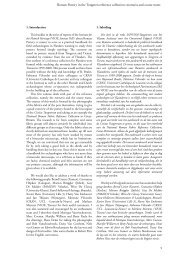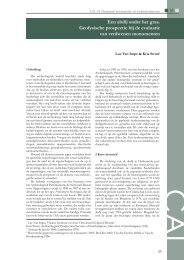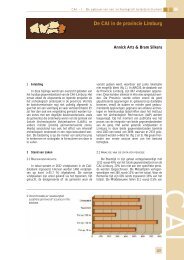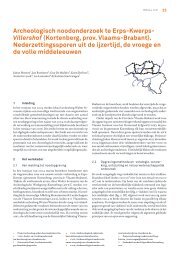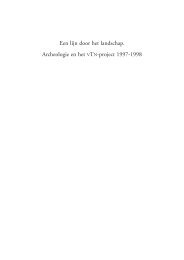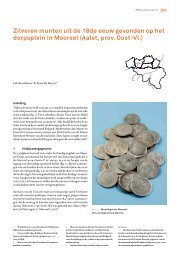Exchanging Medieval Material Culture Studies on archaeology and ...
Exchanging Medieval Material Culture Studies on archaeology and ...
Exchanging Medieval Material Culture Studies on archaeology and ...
You also want an ePaper? Increase the reach of your titles
YUMPU automatically turns print PDFs into web optimized ePapers that Google loves.
16<br />
dries Tys<br />
Fig. 3 Frans with his Brussels<br />
students <strong>on</strong> the fi eldschool<br />
practice in Aalst in 2005.<br />
<strong>on</strong> the historical l<strong>and</strong>scape around Raversyde <strong>and</strong> the history<br />
of the fi shermen’s village. Out of this study followed a PhD<br />
under supervisi<strong>on</strong> of Frans Verhaeghe, <strong>on</strong> the development <strong>and</strong><br />
life trajectory of the medieval rural l<strong>and</strong>scape <strong>and</strong> settlement<br />
structure in coastal Fl<strong>and</strong>ers.<br />
From the early eighties Frans’ own c<strong>on</strong>tributi<strong>on</strong>s to settlement<br />
<strong>archaeology</strong> shift ed gradually more towards urban <strong>archaeology</strong>.<br />
His c<strong>on</strong>necti<strong>on</strong>s with town <strong>archaeology</strong> in Bruges, Antwerp <strong>and</strong><br />
Tours brought <strong>on</strong> the questi<strong>on</strong>s <strong>on</strong> the rise, development <strong>and</strong><br />
organisati<strong>on</strong> of <strong>and</strong> in early medieval towns, a.o. in relati<strong>on</strong> to<br />
the questi<strong>on</strong> <strong>on</strong> c<strong>on</strong>tinuity between Roman <strong>and</strong> medieval towns<br />
in the Southern Netherl<strong>and</strong>s17. What few people know is that<br />
Frans was also member of the Internati<strong>on</strong>al Reference Committee<br />
<strong>on</strong> the excavati<strong>on</strong>s of Birka between 1989 <strong>and</strong> 1996. As well in<br />
the project in Ename Frans played an important advisory role.<br />
He also c<strong>on</strong>tributed to the study <strong>and</strong> publicati<strong>on</strong> of the excavati<strong>on</strong>s<br />
(1989-1991) ‘des Jardins du Carrousel’ in Paris (study <strong>on</strong> the<br />
spatial distributi<strong>on</strong> of archaeological small fi nds <strong>on</strong> the 15th to<br />
16th century parcel structure) <strong>and</strong> was member of the scientifi c<br />
team of the excavati<strong>on</strong>s in Saint-Denis18. He did the study of the<br />
ceramics from the ‘Quartier des foul<strong>on</strong>s’ in Arras (France) <strong>and</strong> of<br />
the lead-glazed Meuse pottery from Oost-Souburgh, <strong>on</strong>e of the<br />
well-known ring forts of the late 9th <strong>and</strong> 10th century in the<br />
Scheldt-estuary. His c<strong>on</strong>tributi<strong>on</strong>s <strong>on</strong> the subject are also of a<br />
methodological <strong>and</strong> theoretical nature, warning us for a correct<br />
<strong>and</strong> critical interpretati<strong>on</strong> of the relati<strong>on</strong> between written <strong>and</strong><br />
material sources <strong>on</strong> these subjects. In the analytical <strong>and</strong> interpretati<strong>on</strong><br />
models <strong>on</strong> the development of early towns, he stressed the<br />
importance of the relati<strong>on</strong> between these urban central places<br />
<strong>and</strong> the importance of trade <strong>and</strong> producti<strong>on</strong> of artefacts. Th e<br />
17 Verhaeghe 1988; Verhaeghe 1990; Verhaeghe<br />
1992; Janssen & Verhaeghe 1993; Verhaeghe 1993;<br />
Verhaeghe 1994; Verhaeghe 1995; Verhaeghe 1998;<br />
Verhaeghe 2005.<br />
PhD’s of Koen De Groote <strong>and</strong> Dirk Callebaut (in progress) are<br />
c<strong>on</strong>nected to this part of his research. His attenti<strong>on</strong> did not <strong>on</strong>ly<br />
go out towards the early towns, but also to the urban phenomen<strong>on</strong><br />
<strong>and</strong> lifestyle in the early modern period, in relati<strong>on</strong> to the<br />
birth of the c<strong>on</strong>sumer society19.<br />
5 Archaeological theory <strong>and</strong> methods<br />
Th roughout his scientifi c thoughts <strong>and</strong> writings, Frans Verhaeghe<br />
has always been very c<strong>on</strong>cerned about the practice of theory<br />
<strong>and</strong> the critical approach of methods. In doing so, he is clearly<br />
a processual thinker, with an emphasis <strong>on</strong> the use of theoretical<br />
<strong>and</strong> even philosophical ideas <strong>and</strong> the critical use of models in<br />
the interpretati<strong>on</strong> of material life. Another aspect was <strong>and</strong> is<br />
the use of natural sciences in <strong>archaeology</strong>, in order to elaborate<br />
the scientifi c dataset with which archaeologists can work to<br />
study the archaeological processes.<br />
With his theoretical writings, he wanted to address both archaeologists<br />
<strong>and</strong> historians working <strong>on</strong> the medieval <strong>and</strong> early modern<br />
period. Many archaeologists, especially in the southern<br />
Netherl<strong>and</strong>s were still comfortable with the role of <strong>archaeology</strong><br />
as an anecdotic <strong>and</strong> descriptive science. In answer to them, he<br />
wanted to stress the potential of <strong>archaeology</strong> as social science,<br />
aimed at the explanati<strong>on</strong> of human behaviour, indeed by using<br />
theory <strong>and</strong> investigating the limits of methods <strong>and</strong> models.<br />
Archaeology was/is not just about describing <strong>and</strong> classifying<br />
sites <strong>and</strong> artefacts, but about interpreting social practices in<br />
their c<strong>on</strong>text. Towards historians he stressed the idea of complementarity<br />
between historical <strong>and</strong> archaeological records <strong>and</strong><br />
interpretati<strong>on</strong>s. Both records document the same past, but<br />
18 Fixot & Verhaeghe 1996.<br />
19 Verhaeghe 1996.


